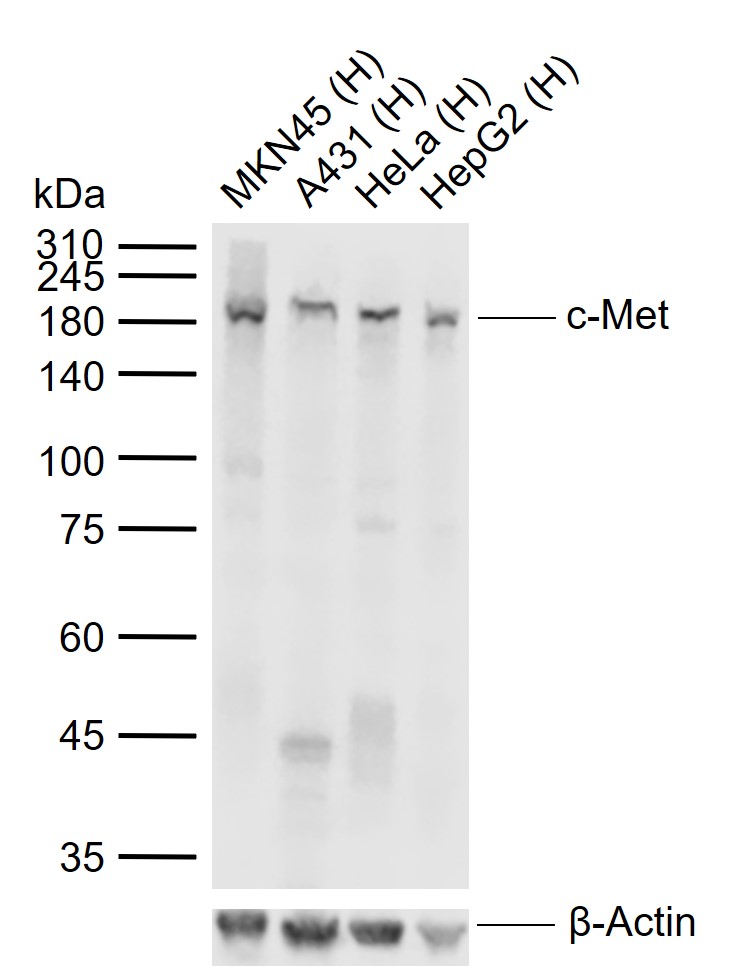
Rabbit Anti-c-Met antibody
MET_HUMAN; Hepatocyte growth factor receptor; EC:2.7.10.1; HGF receptor; HGF/SF receptor; Proto-oncogene c-Met; Scatter factor receptor (SF receptor); Tyrosine-protein kinase Met; MET proto-oncogene, receptor tyrosine kinase; DA11; HGFR; AUTS9; RCCP2; MET
View History [Clear]
Details
Product Name c-Met Alias MET_HUMAN; Hepatocyte growth factor receptor; EC:2.7.10.1; HGF receptor; HGF/SF receptor; Proto-oncogene c-Met; Scatter factor receptor (SF receptor); Tyrosine-protein kinase Met; MET proto-oncogene, receptor tyrosine kinase; DA11; HGFR; AUTS9; RCCP2; MET; c Met; DFNB97; Research Area Tumour immunology Chromatin and nuclear signals Signal transduction Growth factors and hormones transcriptional regulatory factor Kinases and Phosphatases Epigenetics Immunogen Species Rabbit Clonality Monoclonal React Species (predicted: Human, Mouse, Rat, ) Applications WB=1:500-1000 IHC-P=1:100-500 IF=1:50-200 (Paraffin sections need antigen repair)
not yet tested in other applications.
optimal dilutions/concentrations should be determined by the end user.Theoretical molecular weight 155kDa Cellular localization The cell membrane Secretory protein Form Liquid Concentration 1mg/ml immunogen KLH conjugated synthetic peptide derived from human c-Met Lsotype IgG Purification affinity purified by Protein A Buffer Solution 50mM Tris-Glycine(pH 7.4), 0.15M NaCl, 40% Glycerol, 0.01% Sodium azide and 0.05% BSA Storage Shipped at 4℃. Store at -20 °C for one year. Avoid repeated freeze/thaw cycles. Attention This product as supplied is intended for research use only, not for use in human, therapeutic or diagnostic applications. PubMed PubMed Product Detail This gene encodes a member of the receptor tyrosine kinase family of proteins and the product of the proto-oncogene MET. The encoded preproprotein is proteolytically processed to generate alpha and beta subunits that are linked via disulfide bonds to form the mature receptor. Further processing of the beta subunit results in the formation of the M10 peptide, which has been shown to reduce lung fibrosis. Binding of its ligand, hepatocyte growth factor, induces dimerization and activation of the receptor, which plays a role in cellular survival, embryogenesis, and cellular migration and invasion. Mutations in this gene are associated with papillary renal cell carcinoma, hepatocellular carcinoma, and various head and neck cancers. Amplification and overexpression of this gene are also associated with multiple human cancers. [provided by RefSeq, May 2016]
SWISS:
P08581
Gene ID:
4233
Product Picture
Lane 1: Human MKN45 cell lysates
Lane 2: Human A431 cell lysates
Lane 3: Human HeLa cell lysates
Lane 4: Human HepG2 cell lysates
Primary: Anti-c-Met (SLM-34234R) at 1/1000 dilution
Secondary: IRDye800CW Goat Anti-Rabbit IgG at 1/20000 dilution
Predicted band size: 456 kDa
Observed band size: 180 kDa
References (0)
No References
Bought notes(bought amounts latest0)
No one bought this product
User Comment(Total0User Comment Num)
- No comment



 +86 571 56623320
+86 571 56623320
 +86 18668110335
+86 18668110335

